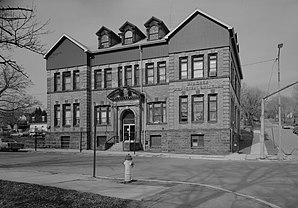Windber
| Windber | ||
|---|---|---|
|
Location in Pennsylvania
|
||
| Basic data | ||
| Foundation : | 1897 | |
| State : | United States | |
| State : | Pennsylvania | |
| County : | Somerset County | |
| Coordinates : | 40 ° 14 ′ N , 78 ° 50 ′ W | |
| Time zone : | Eastern ( UTC − 5 / −4 ) | |
| Residents : | 4,138 (as of 2010) | |
| Population density : | 806.6 inhabitants per km 2 | |
| Area : | 5.13 km 2 (approx. 2 mi 2 ) of which 5.13 km 2 (approx. 2 mi 2 ) is land |
|
| Postal code : | 15963 | |
| Area code : | +1 814 | |
| GNIS ID : | 1215602 | |
 Parish hall 1988 (formerly the main office building of the Berwind-White Coal Mining Company) |
||
Windber is a borough in Somerset County , Pennsylvania , United States , eight miles southeast of Johnstown . Windber was founded in 1897 on the county's northern border by the Berwind-White Coal Mining Company and was part of Paint Township until 1900 . It borders directly on the Boroughs Scalp Level in the northwest and Paint in the west, which today form a contiguous settlement area with Windber. In 2010 there were 4138 people in Windber (according to the 2010 census ), at the time of the flourishing coal mining in the Allegheny Mountains at the beginning of the 20th century it was more than twice as many.
history
In the early 1890s, the coal tycoon Edward Julius Berwind acquired large amounts of land through subsidiaries of the Berwind-White Coal Mining Company in Somerset County and Cambria Counties, which totaled 70,000 acres by 1900 . On this land thirteen hard coal mines went into operation by 1908 (Eureka Mine No. 30-42) . On the border of the counties in the northern part of the Paint Township, the mining company founded the town of Windber in 1897, the name of which is derived from Ber-wind , using the syllables to avoid confusion with Berwind in West Virginia , which is also named after the company's founders were swapped. The town arose southeast of Scalp Level , the then only settlement in the area, along the River Paint Creek (namesake of the township ) on former farmland that the company acquired from David Shaffer in December 1893.
At the turn of the century, mainly immigrants from Europe settled in the city, who extracted hard coal in the mines for the Berwind-White Coal Mining Company . The increasing demand at the beginning of the 20th century for railways and steamers led to a sharp increase in production and the associated need for workers. The number of employees of the mining company increased from 500 in March 1899 to 3,000 in December 1900 and later in the decade to over 4,000. The influx into Windber continued into the 1920s. With the decline in coal production, there was a steady decline in the former population of almost 10,000 from the 1940s and in 2010 it was only 4138 people. Much of the mines in the Windber area closed after the end of World War II , and some remained in operation until the early 1960s. Coal is still mined on a smaller scale in Somerset County to this day.

Windber Historic District
Much of the historic buildings from the early days in Windber, as well as some buildings in the adjacent communities of Paint in Somerset County and Scalp Level in Cambria County were added to the National Register of Historic Places in 1991 as the Windber Historic District (NRHP #: 91001705).
Personalities
- Alan Freed (1921–1965), rock 'n' roll DJ, born in Windber
- George Kuzma (1925–2008), Bishop of the Van Nuys Eparchy, born in Windber
- Nicholas Smisko (1936–2011), Metropolitan of the Carpatho-Russian Church, pastor in Windber in the early 1960s and died here
- Johnny Weissmüller (1904–1984), five-time Olympic champion and actor, spent his childhood in Windber
- J. Irving Whalley (1902–1980), politician, was active in Somerset County and Windber in the 1930s and 1940s
literature
- Mildred Allen Beik: The Miners of Windber: The Struggles of New Immigrants for Unionization, 1890s-1930s. Penn State Press, 2006, ISBN 978-0271029900 .
Web links
- Windber Borough. official website
- Windber Coalfield. Coalfields of the Appalachian Mountains
- A Walking of Historic Windber. Greater Johnstown / Cambria County Convention & Visitors Bureau
Individual evidence
- ^ Pennsylvania: 2010, Population and Housing Unit Counts. US Department of Commerce Economics and Statistics Administration, 2012. Retrieved February 1, 2015.
- ^ A b Jeff Goodell: Big Coal: The Dirty Secret Behind America's Energy Future. Houghton Mifflin Harcourt, 2006, ISBN 978-0-618-31-940-4 , pp. 29-31.
- ^ A b Mildred Allen Beik: The Miners of Windber: The Struggles of New Immigrants for Unionization, 1890s-1930s. Penn State Press, 2006, p. 17.
- ^ Mildred Allen Beik: The Miners of Windber: The Struggles of New Immigrants for Unionization, 1890s-1930s. Penn State Press, 2006, pp. 9-14.
- ^ Census of Population and Housing 1790-2010. US Census Bureau. Retrieved February 1, 2015.
- ^ Mildred Allen Beik: The Miners of Windber: The Struggles of New Immigrants for Unionization, 1890s-1930s. Penn State Press, 2006, pp. 352 f.
- ^ Windber Coalfield. Coalfields of the Appalachian Mountains, A Scrapbook of Appalachian Coal Towns. Retrieved February 1, 2015.
- ↑ Gerald M. Kuncio: Windber Historic District - National Register of Historic Places Registration Form. United State Department of the Interior, National Park Service, 1991.
